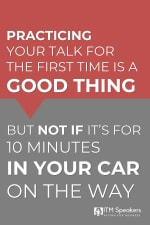 How does Steph Curry hit ridiculously long 3-point shots? How does Denzel Washington make every character unique and mesmerizing? Why does every Apple product launch presentation seem so professional? All the same reason? Practice. Steph spends thousands of hours in the gym making sure each jump shot is identical. Denzel reviews each line inflection and head turn. Apple has each exec up on the stage running, and re-running their talks until they are instinctual and polished. But, a lot of people when asked whether they practiced the talk they are about to give, or meeting kick-off they are about to present, will say either no or I went over it in the car. That is not good enough. I realize that sometimes there is not much time to practice, but if you can find 15 minutes to stand in an empty room and say out loud what you're planning to communicate, you will find that you are much more relaxed because of that short preparation. Here are a few tips:
I've seen good speakers flounder because they didn't have enough prep time, and I've seen nervous speakers soar once they've rehearsed. Invest some time in yourself and rehearse.
0 Comments
 If you didn't know that Cinderella had a horrible stepmother and stepsisters would her story be as good? Nope. If Cinderella lived in a four bedroom colonial with two and half baths on a cul-de-sac and then married a prince it wouldn't be much of a story. The same holds true for any business story. If you have a customer story without contrast how would your viewer know how big an improvement you've created with your product or service? There are a lot of different ways to show contrast. Here are my two favorites: 1. Show it with numbers If your customers took three weeks to complete a task that now can be done in 20 minutes that should be the backbone of your story. Look for time, money or effort savings. You can also look for product or platforms that are eliminated from a workflow. Numbers are king, but it's not the only way to show contrast. 2. Show a person's journey Engaging the emotions of your listener is a great way to connect and be memorable. If a person joined a company because they wanted to help the organization achieve a mission and your product or service helped them to that end it shows contrast. The journey shows a before and after and can be highly memorable by adding emotion to the story. The viewer can identify with the person in the story and imagine themselves on their own journey or success. Contrast is king, but it's common to see and hear stories where it's omitted. So, do a double check on every story you tell and you'll see the results. 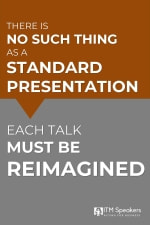 I have a confession to make. I have created hundreds of "Standard Sales Decks" in my career. I have spent hours building 100-slide Library Decks, streamlined PowerPoints for vertical industry pitches, and more than I care to remember. I can't imagine how many people I've hurt with good intentions. When I supplied a standard deck with scripting and notes it set the wrong expectation. I was saying that if a sales person or executive just presented the messages I gave them they would be successful. This put all the focus on the speaker, their company and their product and not on the listener. Having some standard concepts, talk tracks and slides is fine, but start with what's important to the listeners. What are they looking to hear and learn about and re-imagine your talk. Think about how you can be intriguing and interesting to them and carry them on a journey with your storytelling. You are the guide to their journey and not a UPS driving delivering a standard package. A storyteller is an artist, and a great painter would never show up with a finished painting. They show up with the tools and materials to create one. 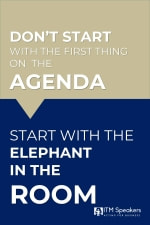 In the early 2000s I was working for a company that got acquired. This was the first time this had happened in my career, so I wasn't familiar with the process. The CEO of the company that acquired us was Andrew "Flip" Filipowski. Flip has started, bought and sold many companies and is a really impressive guy, but what he did in our first company meeting with him taught me a lesson. Flip walked in and greeted the room and the immediately said, "You're all probably wondering how all this effects you personally." He then gave us as much detail as he could about what was going to happen and how we would experience the process. Flip knew that until we were put at ease with our personal concerns we weren't going to really listen to anything else. It was a great lesson. If there is something that is hanging in the thoughts of the audience, and regardless of what you want to start with on your agenda, try to handle that elephant. If you don't, the room will not be focused on what you want them to think about. 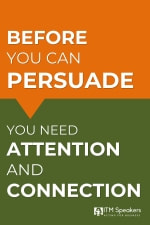 Most business people are familiar with Maslow's Hierarchy of Needs, but have you thought about the Hierarchy of Communications? Depending on the type of communication the top level can be different, but for most situations the goal is to persuade. You might be selling a product, a vision or a concept, but you want to change the thinking of the person or group you're addressing. Here are the steps we talk about at ITM Speakers: 1. Attention - This is the easiest to achieve. Your audience has put down their phones, closed their laptops and aren't talking. Simply put, they are listening. This is easiest to get, but keeping it takes skill and work. 2. Connection - They have found something that is of interest, or is intriguing, in your talk. Watch for them to be leaning forward and their expressions to change. 3. Persuasion - Once you have them actively listening you have the chance to make your case on why they should change their thinking. How compelling is your argument? Are you applying your argument in a way that makes it the most compelling? Climbing a set of steps quickly and effectively requires two things; first you have to know the steps are there, and secondly you need the skills to do it without tripping. ;-) 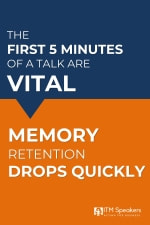 There is a thing called the Primacy Effect which is a psychological phenomenon associated with memory that says that items at the beginning (primacy) of a list or string of information are more easily recalled than items in the middle. That's why it's vital to start every meeting or presentation with something that drives intrigue. Nature has given speakers a gift in the first 5 minutes where what he or she introduces is more likely to be remembered. Most people don't use it. Don't open your talk with procedural information if you can avoid it. Start with something evocative. Even if you are just running a status meeting you could start by saying that the team is 15% ahead of schedule...or 15% behind. Start with a bang and then keep trying to introduce "moments of change" during your talk to maintain attention. Basically, with each moment of change you are resetting the listener's minds so that you get that instance of primacy again, and have 5 minutes of fresh attention. Use a story, question, move yourself, throw a ball, etc. to jar the viewer into a new mind set.  When I teach classes I promise that everything I share is backed by science, research and experience. There is a lot of talk about storytelling and how it can be used in selling. That might be selling an idea to an audience, or selling a product to a consumer, but why does it work? Storytelling is a triple threat. A good story increases the amount of cortisol, dopamine, and oxytocin in the human body. Cortisol drives attention, dopamine keeps the viewer attentive by reinforcing with pleasurable feelings, and oxytocin promotes pro-social, empathetic behavior. Put that cocktail together and it drives human behavior in a way that's beneficial to the storyteller. The only bad news there is that you need to tell a GOOD story. Not everyone is a natural storyteller, or knows how to create a story that supports their business goals. The good news, is that those skills can be learned and there are good frameworks for stories that can be leveraged to help creativity. 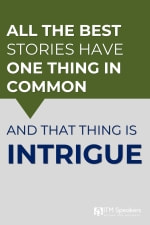 Every time I talk to people about speaking and storytelling there is one word that I love to use. I love to use it both because it's accurate, but also because we don't get to use it much in day-to-day conversation. That word is....INTRIGUE! You don't have to be a infamous spy or thriller writer to use it, but you don't often hear it in polite conversation. But it describes what every public speaker should be striving for in their talks. Create intrigue! Make the people you're talking to want to hear how your story ends. Even if you are just having a status meeting try to find some little bit of information to hold back. Make people lean forward in their chairs. Even if it's just something as basic as, "At the end of the meeting I'm going to share some lessons the team learned over the past week." Is that a who-dun-it worthy of Alfred Hitchcock, no, but it doesn't have to be. If you're doing a main stage talk at a conference you can build in more drama, but always try to give people a reason to stay to the end. #training #communication #storytelling #itmspeakers 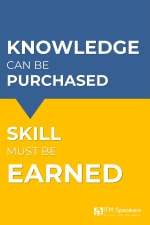 I make a living helping people be more concise, compelling and persuasive communicators, so today's theme might seem a little contradictory, but it's very true. I can come in and teach people skills, and even show them the science behind why what I teach works, but that doesn't help them if they don't practice and repeatedly apply that knowledge to create good habits. Developing a valuable ability requires the student to rinse and repeat to change knowledge into skill. Your brain is a muscle, and "muscle-memory" enables you to lock in skills so you don't have to think about them, and can improve them and layer new skills on top. Steph Curry doesn't think about shooting, but the tens of thousands of hours where he's taken knowledge to create skill from what he's learned are all buried in his amazingly consistent jump shot. Anyone who is great has two skills. One; they are open to learn from other's successes and failures, and two; they've practiced until their skills have been ingrained into them. #communication #presenting #training #storytelling #personaldevelopment #publicspeaking  I've worked with hundreds of career sales people, and while some of them are very confident speakers with great content, a lot of them display body language that conflicts with their words and limits their effectiveness. Here are a few things to think about. 1. Am I facing my audience and connecting with them, or am I referring too much to my slides? 2. Am I using body language that shows confidence and openness? 3. Do I focus on the people in the room and not the process of talking? Good body language changes a speaker's body chemistry to reinforce confidence and minimize stress. It's a bio-mechanical loop. The funny thing is that the audience reads it too, and it makes them more open to connect, listen and hear your message. #sales #training #communication #storytelling #bodylanguage |
Categories
All
Robert MattsonRobert is a speaker coach, actor, director, author, speaker, executive and overall marketing guy. He writes about all aspects of presenting and connecting with audiences. Archives
April 2019
|


 RSS Feed
RSS Feed